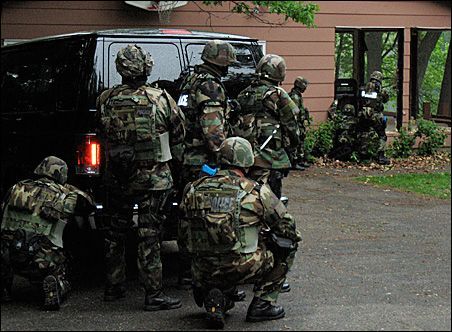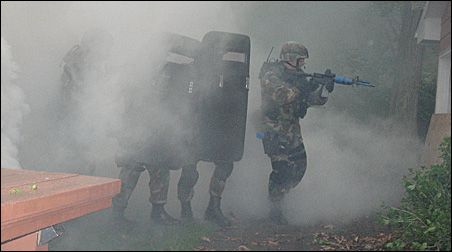Editor’s Note: The following article by Susan Perry first appeared on MinnPost.com and is printed by permission of the publisher.
By Susan Perry
MinnPost.com
 A SWAT team prepares to enter the Scolls’ house. (MinnPost photo by Susan Perry) |
TWIN CITIES, Minn. — On a gray, rainy morning last month, Jon and Barbara Scoll calmly sipped coffee on their private dock while 100 feet away a SWAT team broke down the front door to their Edina home and swarmed across the threshold, guns held high.
The team’s breach man had to pound the door five times with his steel battering ram before it finally gave way.
“He should have gotten in with two hits,” said St. Louis Park police officer Mike Merwin to the Scolls. “You had a good door.”
“Who knew?” said Barbara Scoll.
Most people, of course, are anything but nonchalant when a SWAT team comes banging on their door. For the Scolls, however, the raid on their home last month was not only eagerly anticipated, but invited.
They’re among a small number of Twin Cities homeowners who have donated their houses to their local police or fire department to use for training before the house is razed to make room for a newer model.
Such donations benefit both the receiver (the public safety department) and the giver (the homeowner). The police or fire department gets a soon-to-be-scrapped house to use for training and the homeowner gets a tax deduction.
Donating a house isn’t as easy as it sounds, however. A lot depends on where you live and whom you call.
And if not done right, taking the tax deduction could put you in hot water with the Internal Revenue Service.
A chance to get real
The police were thrilled to get use of the Scolls’ 3,200-square-foot 1960s rambler before the demolition crew arrived.
“When we hear about a house like this we get really excited because it makes the training much more realistic,” explained Merwin.
The St. Louis Park Police Department used the house to host a joint training session with SWAT teams from four other suburban police departments: Eden Prairie, Edina, Hopkins and Minnetonka. Together, they enacted half-a-dozen real-life scenarios, each time turning the house into a different setting.
In one scenario, for example, the house became a meth lab with an undercover officer inside. In another, the house morphed into a medical clinic with an armed, mentally ill man holding doctors and patients hostage. Non-uniformed officers played both the “bad guys” and “innocent bystanders.” (Hollywood, take note: There was some fairly good acting involved.)
The training sessions looked very realistic, complete with flash-bang grenades, a BearCat armored vehicle, and camouflaged police snipers hiding in the nearby woods, their rifles (armed with blank ammunition) aimed at the house.
To prepare Edina’s Indian Hills neighborhood for the SWAT teams’ maneuvers, the police distributed fliers several days before. The information must have reached everyone within earshot of the training, for Merwin reported no frantic 911 calls from residents that morning.
Tax break?
“Giving” away the home where they had lived for 20 years turned out to be more difficult than the Scolls had originally expected.
“Initially, our financial planner said this would be a good idea financially,” said Barbara Scoll. She and her husband were told that they might be able to take a substantial charitable deduction on their tax return.
The Scolls’ accountant, however, was less than enthusiastic. It’s a sure way of getting audited, he told them. The IRS has been cracking down on such deductions and had even recently taken a Wisconsin homeowner to court on the issue, he said.
 After a training scenario is completed, SWAT team members gather on the Scolls’ porch for a debriefing. (MinnPost photo by Susan Perry) |
Indeed, finding a local CPA or tax attorney who knows anything about this particular deduction is difficult, perhaps because it’s used by only a handful of homeowners each year.
“I’ve advised two or three over the years who have actually done it,” said Tom Johnson, a partner with the Minneapolis-based accounting firm Boulay, Heutmaker, Zibell & Co. Many people ask him about it, he said, but few actually go through with making the donation and taking the deduction.
Location, location, location
The first obstacle, Johnson pointed out, is getting your local police or fire department to accept the house for a donation. How successful you are may depend on where you live.
It seems that donating a house, like buying and selling one, comes down to three words: location, location, location.
The Scolls, for example, were turned down by Edina’s police and fire departments, each of which receives about half a dozen offers of houses annually — more than they can use.
“Not every training session involves a warrant service or a barricaded suspect in a home,” explained Sgt. Brian Tholen, team leader for the 14-member Edina SWAT team. “We really appreciate [offers of homes], but we can’t always use them.”
Other police departments, like St. Louis Park and Minneapolis, aren’t so lucky. “We never get the opportunity,” bemoaned Sgt. Jesse Garcia of the Minneapolis Police Department.
Why Edina receives more offers than its neighboring municipalities is unclear. Perhaps Edina has more tear-downs, or perhaps more homeowners there are aware that public safety departments will use houses for training — and that donating a house for such purposes may have beneficial tax ramifications.
A realistic appraisal
If your local police or fire department does accept your home, your next step is to have the house appraised, said Johnson. In fact, you’ll need two appraisals — one before and one after the training event.
“Your charitable deduction is the difference between those two [appraisals],” said Johnson.
 A smoke grenade is set off to screen a SWAT team as it enters the house. (MinnPost photo by Susan Perry) |
And, yes, you must use an independent certified appraiser. “The IRS requires that someone stand behind the appraisal,” explained Johnson. “You can’t just have your local real estate agent say, ‘Well, it’s worth X and Y.’ ”
For this step of the process, you’ll need IRS form 8283 (Noncash Charitable Contributions), Johnson advised. It must be signed by both the recipient of the donation (a representative of the police or fire department) and the appraiser.
Don’t expect much help from the IRS. In an email response to a MinnPost request for information, IRS spokesperson Carrie Resch wrote that she couldn’t “provide an across-the-board answer on whether donating a home to a fire department for training purposes is an allowed deduction. It depends on many facts and circumstances.”
She declined to explain what those facts and circumstances might be. Instead, she advised taxpayers to read IRS publications 526 (Charitable Contributions) and 561 (Determining the Value of Donated Property). To download, go to the IRS’ “Forms and Publications” page.
Resch also declined to provide any details about the Wisconsin case in which the IRS is reportedly suing a homeowner for taking a deduction on a donated home because, she noted, “it’s still in litigation.”
Another kind of green
Given the difficulty with finding a police or fire department that will take a donated house, the fuss and expense of getting the appraisals (and having a tax accountant double- check everything), the IRS’ apparent skepticism about this deduction, and the often small amount that can actually be deducted (in many cases, only the cost of a few ruined doors and other architectural features), it’s no wonder that many of the people who ask about the deduction eventually give up on the idea.
Barbara and Jon Scoll, however, hesitated for only a few days before going ahead with the hassle of arranging the donation. “We decided the deduction wasn’t the motivating factor,” explained Barbara. “We wanted to contribute to the community.”
The couple also viewed the donation as part of their effort to build their new house as “green” and sustainable as possible. (The new house is going to be 800 square feet smaller than the former one.)
“We wanted to maximize the reuse of every feature of the house,” said Jon.
 Police snipers dressed in lightweight ghillie camouflage suits wait for the next training session to begin. (MinnPost photo by Susan Perry) |
Before the police got the house, the Scolls managed to sell or give away almost every architectural element of value in the house, including floorboards, kitchen countertops, light fixtures, bathtubs, built-in closet organizers, and even the stair railing to the second floor.
That last item proved a bit of a problem for the police, who had to construct a makeshift railing before their training session to protect their officers from injury.
At the end of last month’s training session, almost every remaining element of the Scolls’ house was used, from the roof, where a “bad guy” was “shot” by a police sniper, to the basement, where members of the SWAT team shattered windows to gain entrance during a “raid.”
And how did it feel to see her house destroyed before her eyes? “I’m glad I did it. This seems very useful,” said Barbara. “It’s also good to see how hard they work to protect us. That feels good, too.”
Copyright 2008 TheMinnPost.com










